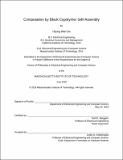| dc.contributor.advisor | Karl K. Berggren. | en_US |
| dc.contributor.author | Do, Hyung Wan | en_US |
| dc.contributor.other | Massachusetts Institute of Technology. Department of Electrical Engineering and Computer Science. | en_US |
| dc.date.accessioned | 2018-09-17T14:51:53Z | |
| dc.date.available | 2018-09-17T14:51:53Z | |
| dc.date.copyright | 2018 | en_US |
| dc.date.issued | 2018 | en_US |
| dc.identifier.uri | http://hdl.handle.net/1721.1/117840 | |
| dc.description | Thesis: Ph. D., Massachusetts Institute of Technology, Department of Electrical Engineering and Computer Science, 2018. | en_US |
| dc.description | This electronic version was submitted by the student author. The certified thesis is available in the Institute Archives and Special Collections. | en_US |
| dc.description | Cataloged from student-submitted PDF version of thesis. | en_US |
| dc.description | Includes bibliographical references. | en_US |
| dc.description.abstract | Unconventional computation is a paradigm of computation that uses novel information tokens from natural systems to perform information processing. Using the complexity of physical systems, unconventional computing systems can efficiently solve problems that are difficult to solve classically. In this thesis, we use block copolymer self-assembly, a well-studied phenomenon in polymer science, to develop a new approach to computing by applying directed self-assembly to implement Ising-model-based computing systems in materials. In the first part of the thesis, we investigate directed self-assembly of block copolymer thin films within templates of different polygonal shapes. We define a two-state system based on the two degenerate alignment orientations of the ladder-shaped block copolymer structures formed inside square confinements, and study properties of the two-state system. In the second part of the thesis, we demonstrate an Ising lattice setup for directed self-assembly of block copolymers defined on two-dimensional arrays of posts. We develop an Ising-model-based simulation method that can perform block copolymer pattern prediction and template design. Finally, we design simple Boolean logic gates as a proof-of-concept demonstration of computation. | en_US |
| dc.description.statementofresponsibility | by Hyung Wan Do. | en_US |
| dc.format.extent | 125 pages | en_US |
| dc.language.iso | eng | en_US |
| dc.publisher | Massachusetts Institute of Technology | en_US |
| dc.rights | MIT theses are protected by copyright. They may be viewed, downloaded, or printed from this source but further reproduction or distribution in any format is prohibited without written permission. | en_US |
| dc.rights.uri | http://dspace.mit.edu/handle/1721.1/7582 | en_US |
| dc.subject | Electrical Engineering and Computer Science. | en_US |
| dc.title | Computation by block copolymer self-assembly | en_US |
| dc.type | Thesis | en_US |
| dc.description.degree | Ph. D. | en_US |
| dc.contributor.department | Massachusetts Institute of Technology. Department of Electrical Engineering and Computer Science | |
| dc.identifier.oclc | 1052123996 | en_US |
